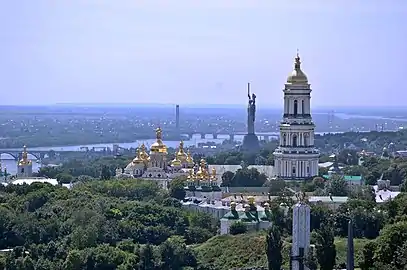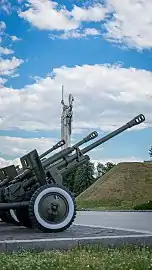Україна-мати | |
 The monument in August 2023 after decommunisation | |
| 50°25′35″N 30°33′47″E / 50.426521°N 30.563187°E | |
| Location | National Museum of the History of Ukraine in the Second World War, Pechersk, Kyiv, Ukraine |
|---|---|
| Designer | Vasyl Borodai |
| Material | Titanium |
| Height | 102 m (335 ft) |
| Beginning date | 1979 |
| Opening date | May 9, 1981 |
| Dedicated to | Motherland Ukraine Russo-Ukrainian War Soviet victory in WWII (originally) |
| Website | Official webpage |
Mother Ukraine (Ukrainian: Україна-мати, romanized: Ukraína-máty [ʊkrɐˈjinɐ ˈmɑtɪ]) is a monumental Soviet-era statue in Kyiv, the capital of Ukraine. The sculpture is a part of the National Museum of the History of Ukraine in the Second World War.[1] In 2023, the Soviet heraldry was removed from the monument's shield and replaced with Ukraine's coat of arms, the tryzub.[2][3][4]
Name
The monument's initial name was the Mother Motherland (Ukrainian: Батьківщина-мати, romanized: Batkivshchýna-máty), which derives from Russian Mother Motherland (Russian: Родина-мать, romanized: Rodina-mat'), a name for the national personification used by both Russia and the Soviet Union. Along with other monuments built across the USSR (e.g. The Motherland Calls in Volgograd, Russia), the statue originally symbolized Soviet victory in the Second World War. On 29 July 2023, amidst the removal of the Soviet heraldry from the monument, the director of the memorial complex Yuri Savchuk announced that it would be renamed to Mother Ukraine.[5]
Description
The titanium statue stands 62 m (203 ft) tall with the overall structure measuring 102 m (335 ft) including its base and weighing 560 tonnes. The sword in the statue's right hand is 16 m (52 ft) long, weighing 9 tonnes, with the left hand holding up a 13 by 8 m (43 by 26 ft) shield originally emblazoned with the hammer and sickle emblem of the Soviet Union. Initially, the statue was drawn by the sculptor Yevgeny Vuchetich.[6] Vuchetich based the statue on the Ukrainian painter Nina Danyleiko.[7] [8] When Vuchetich died in 1974, the project was continued by Vasyl Borodai, who used Ukrainian sculptor Halyna Kalchenko, a daughter of the Chairman of the Council of Ministers of the Ukrainian SSR Nikifor Kalchenko, as the model.[6]
The base of the statue houses the National Museum of the History of Ukraine in the Second World War. The memorial hall of the museum displays marble plaques with carved names of more than 11,600 soldiers and over 200 workers of the home-front honoured during the war with the title of the Hero of the Soviet Union and the Hero of Socialist Labour. On the hill beneath the museum, traditional flower shows are held. The sword of the statue was shortened by four meters from its project height. Some sources claim this was done so that the tip of the sword was lower than the cross of the Kyiv Pechersk Lavra.[9] However, in reality it was done to resolve aerodynamic problems identified during wind tunnel testing by specialists from Moscow.[10]
Background
In the 1950s there were plans to construct twin monuments of Vladimir Lenin and Joseph Stalin, nearly 200 m (660 ft) tall each on the site.[11] However, this did not go ahead. Instead, according to legend, in the 1970s, a group of Communist Party officials and Soviet sculptor Yevgeny Vuchetich looked across at the hills by the Lavra and decided the panorama needed a war memorial. Vuchetich had designed the other two most famous giant Soviet war memorials, The Motherland Calls in Volgograd and the Soviet soldier carrying German infant in East Berlin. The statue was modelled after one of his coworkers, Mila Hazinsky, however, after Vuchetich died in 1974, the design of the memorial was substantially reworked, and only the eyes and eyebrows remained from the original face. It was then completed under the guidance of Vasyl Borodai.
In 2023 Ukrainian TV channel 1+1 interviewed the grandson of Vasyl Borodai who presented them with the original projects of the statue. According to him, the sculptor originally wanted the statue hold a palm branch, the symbol of peace, however the Communist Party wanted a sword.[12]
Final plans for the statue were made in 1978, with construction beginning in 1979. It was controversial, with many criticising the costs and claiming the funds could have been better spent elsewhere. When Director of Construction Ivan Petrovich was asked to confirm the cost of 9 million rubles, he responded that this was a conservative estimate. The statue was opened in 1981 in a ceremony attended by Soviet General Secretary Leonid Brezhnev.
In modern-day Kyiv, the statue remains controversial, with some claiming it should be pulled down and its metal used for more functional purposes. Financial shortages mean that the flame, which uses up to 400 m3 (14,000 cu ft) of gas per hour, can only burn on the most prominent national holidays, and rumours persist that the statue is built on unstable foundations, something vehemently denied by the Kyiv city government.[13][14]
In popular culture
A scene in the 2006 novel World War Z depicts a Ukrainian tank commander and his surviving men fleeing in their vehicles from an abandoned and burning Kyiv under the watchful gaze of the monument.[15]
The monument was the site of a pit stop during the tenth episode of The Amazing Race 10.[16]
.png.webp)
The monument is prominently featured in the music video for the song "Get Out" by the Scottish band Frightened Rabbit.[17]
Decommunisation
In April 2015, the parliament of Ukraine outlawed Soviet and communist symbols, street names, and monuments as part of the decommunisation of Ukraine.[18] However, World War II monuments are excluded from these laws.[19] Director of the Ukrainian Institute of National Remembrance Volodymyr Viatrovych stated in February 2018 that the Soviet state emblem on the shield of the monument should be removed to comply with the country's decommunisation laws and replace it with the Ukrainian trident coat of arms.
With the start of Russian invasion of Ukraine in 2022 the derussification process had begun in order to remove Russia's influence in Ukraine.
On 6 May 2023, the Ministry of Culture announced that plans to remove the Soviet crest and replace it with the Ukrainian tryzub were underway.[20][21]
On 13 July 2023, the DIAM urban planning agency announced that the Soviet state emblem would be replaced with the Ukrainian trident coat of arms. DIAM claims that in 2022, 85% of 800,000 consulted citizens favoured replacing the Soviet imagery with the trident emblem.[22][23] The work to remove the Soviet emblem began on 13 July 2023.[2]
On 1 August, the Soviet emblem was removed from the Motherland Monument.[24] Its replacement by the Ukrainian Trident, designed by Ukrainian sculptor Oleksiy Perhamenshchyk, began on 5 August 2023, as part of the preparations for the Independence Day of Ukraine on 24 August. It was completed on schedule despite the crew facing problems of intense wind, heavy rain and Russian air raids.[25][26]
Gallery
 The monument on a 1984 Soviet stamp "40th anniversary of the liberation of Soviet Ukraine from German fascist invaders"
The monument on a 1984 Soviet stamp "40th anniversary of the liberation of Soviet Ukraine from German fascist invaders".jpg.webp)
 View with Kyiv Pechersk Lavra
View with Kyiv Pechersk Lavra
See also
References
- ↑ "Kirilenko Museum of the Great Patriotic War renamed". PDA Pravda. Retrieved 9 September 2016.
- 1 2 Vox Pop: Ukrainians On Changing Symbols On Iconic Kyiv Statue, 28 July 2023, retrieved 30 July 2023
- ↑ Visegrand 24, 31 July 2023
- ↑ Lister, Tim; Voitovych, Olga; Kottasová, Ivana; Noor Haq, Sana (7 August 2023). "Ukraine replaces Soviet-era hammer and sickle symbol with a trident on Kyiv statue". CNN. Retrieved 7 August 2023.
- ↑ Court, Elsa (1 August 2023). "Soviet coat of arms removed from Kyiv's Motherland Monument". Reuters.
- 1 2 "Це потрібно відчути" [This needs to be experienced]. Olevsk city portal (in Ukrainian). 28 October 2010. Archived from the original on 18 December 2017. Retrieved 13 April 2022.
- ↑ "Народне малярство Ніни Данилейко" [National artistry of Nina Danyleiko]. Ivan Honchar Museum (in Ukrainian). 24 May 2013. Archived from the original on 16 August 2021. Retrieved 13 April 2022.
- ↑ Borysenko, M. (22 August 2008). "Ніна Данилейко народила шестеро дітей" [Nina Danyleiko gave birth to six children]. Gazeta (in Ukrainian). Retrieved 13 April 2022.
- ↑ "Motherland Monument". Ukrainian State Museum of the Great Patriotic War of 1941-1945. Archived from the original on 4 May 2015.
- ↑ https://myukraine.org.ua/batkivshchyna-maty/
- ↑ "Forgotten Soviet Plans For Kyiv". Kyiv Post. 28 July 2011. Archived from the original on 4 February 2012.
- ↑ https://www.youtube.com/watch?v=K-uPrTePD-4
- ↑ Bayer, Martin (11 August 2010). ""Mother Motherland" (Kiev) and more works by Vuchetich". Wartist. Retrieved 9 September 2016.
- ↑ "Ukraine Kiev Sights | Mother Motherland Statue-Monument". Ukraine-kiev-tour.com. 9 May 1981. Retrieved 9 September 2016.
- ↑ Brooks, Max, World War Z, p.118, Duckworth Overlook, ISBN 978-0-7156-3996-2
- ↑ "The Amazing Race 10 - Episode 10 Summary". Reality TV World. 19 November 2006. Retrieved 19 September 2020.
- ↑ "Frightened Rabbit - "Get Out" [Official]". Vimeo. 3 March 2016. Retrieved 25 May 2016.
- ↑ Ukraine MPs back ban on Nazi and Communist propaganda, BBC News. 9 April 2015
- ↑ Shevchenko, Vitaly (14 April 2015). "Goodbye, Lenin: Ukraine moves to ban communist symbols". BBC News. Retrieved 17 May 2015.
Poroshenko signed the laws about decomunization. Ukrayinska Pravda. 15 May 2015
Poroshenko signs laws on denouncing Communist, Nazi regimes, Interfax-Ukraine. 15 May 2015 - ↑ "Ukraine to replace Soviet emblem on Motherland statue with Ukrainian trident". The Kyiv Independent. 6 May 2023. Retrieved 6 May 2023.
- ↑ The Massive Trident Destined For Kyiv's Motherland Monument Radio Free Europe/Radio Liberty (https://www.rferl.org). July 20, 2023. Retrieved on 2023-07-22.
- ↑ Kitsoft. "Державна інспекція архітектури та містобудування України - Декомунізація "Батьківщини-мати"!". diam.gov.ua (in Ukrainian). Archived from the original on 13 July 2023. Retrieved 13 July 2023.
- ↑ "DIAM Facebook - Декомунізація "Батьківщини-мати"!". www.facebook.com. 13 July 2023. Retrieved 13 July 2023.
- ↑ Ogirenko, Valentyn (1 August 2023). "In pictures: Soviet emblem cut off Ukraine's Motherland Monument". Reuters.
- ↑ "Ukraine replaces Soviet hammer and sickle with trident on towering Kyiv monument". ABC News. Retrieved 7 August 2023.
- ↑ "Culture Ministry: Work begins to replace Soviet symbols on Motherland Monument". The Kyiv Independent. 30 July 2023. Retrieved 3 August 2023.